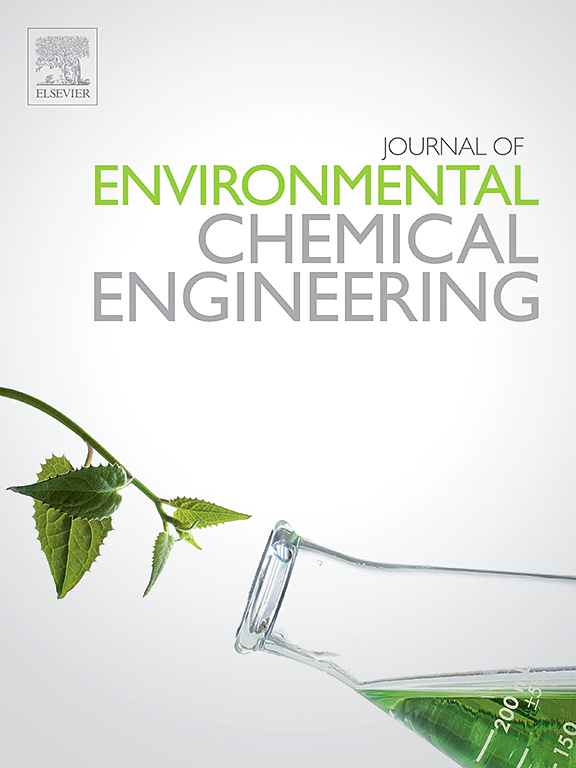具有分层多孔结构的镍离子交换阴离子Cu-MOF吸附脱硫
IF 7.2
2区 工程技术
Q1 ENGINEERING, CHEMICAL
引用次数: 0
摘要
吸附脱硫技术具有经济实惠、操作条件温和等优点,是一种很有发展前途的脱硫方法。金属有机骨架(mof)因其具有比表面积大、孔隙体积大、结构可设计等特点而受到广泛关注。通过加入水杨酸和水热法制备了层次化多孔cutc - dma。随后,采用离子交换法将Ni离子引入到结构中。结果表明,水杨酸和Ni的掺杂对材料的结构没有明显的改变。制备了新型π络合吸附剂Ni@HP-CuBTC-DMA。吸附脱硫实验结果表明,[email protected](0.2 M)对噻吩和苯并噻吩的吸附量最大,分别为25.63 mg S/g和41.06 mg S/g。在甲苯竞争实验中,噻吩的吸附量仍可达到19.25 mg S/g。再生实验结果表明,[email protected](0.2 M)经过4次循环后仍具有优异的吸附能力。本文章由计算机程序翻译,如有差异,请以英文原文为准。
Nickel ion-exchanged Anionic Cu-MOF with Hierarchically Porous Structure for Adsorption Desulfurization
The adsorption desulfurization technology presents remarkable advantages and is a promising method because of its affordability, gentle operating conditions. Metal-organic frameworks (MOFs) have garnered significant attention owing to their remarkable features, including large specific surface areas, pore volume and the designable structure. The hierarchical porous CuBTC-DMA was successfully synthesized by adding salicylic acid and using the hydrothermal method. Subsequently, Ni ions were introduced into the structure using ion-exchange method. It was found that the doping of salicylic acid and Ni did not significant alter the structure of the material. The new type of π-complexed adsorbent, Ni@HP-CuBTC-DMA, was prepared. The results of adsorption desulfurization experiments showed that [email protected](0.2 M) had the highest adsorption capacity, with the maximum adsorption amounts of 25.63 mg S/g and 41.06 mg S/g for thiophene and benzothiophene, respectively. In the toluene competition experiment, the adsorption amount of thiophene could still reach 19.25 mg S/g. The results of regeneration experiments demonstrate that [email protected](0.2 M) still has excellent adsorption capacity after four cycles.
求助全文
通过发布文献求助,成功后即可免费获取论文全文。
去求助
来源期刊

Journal of Environmental Chemical Engineering
Environmental Science-Pollution
CiteScore
11.40
自引率
6.50%
发文量
2017
审稿时长
27 days
期刊介绍:
The Journal of Environmental Chemical Engineering (JECE) serves as a platform for the dissemination of original and innovative research focusing on the advancement of environmentally-friendly, sustainable technologies. JECE emphasizes the transition towards a carbon-neutral circular economy and a self-sufficient bio-based economy. Topics covered include soil, water, wastewater, and air decontamination; pollution monitoring, prevention, and control; advanced analytics, sensors, impact and risk assessment methodologies in environmental chemical engineering; resource recovery (water, nutrients, materials, energy); industrial ecology; valorization of waste streams; waste management (including e-waste); climate-water-energy-food nexus; novel materials for environmental, chemical, and energy applications; sustainability and environmental safety; water digitalization, water data science, and machine learning; process integration and intensification; recent developments in green chemistry for synthesis, catalysis, and energy; and original research on contaminants of emerging concern, persistent chemicals, and priority substances, including microplastics, nanoplastics, nanomaterials, micropollutants, antimicrobial resistance genes, and emerging pathogens (viruses, bacteria, parasites) of environmental significance.
 求助内容:
求助内容: 应助结果提醒方式:
应助结果提醒方式:


